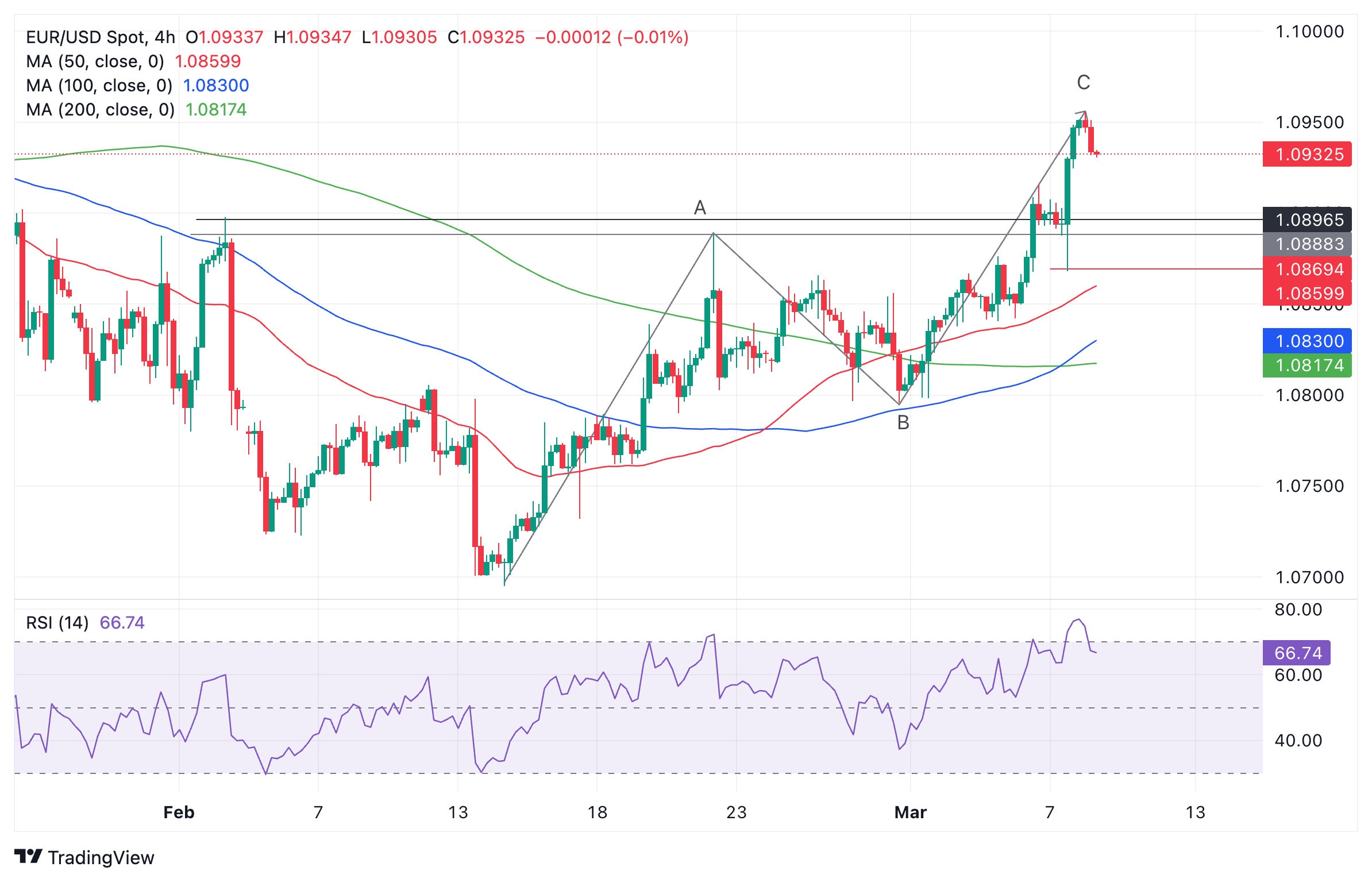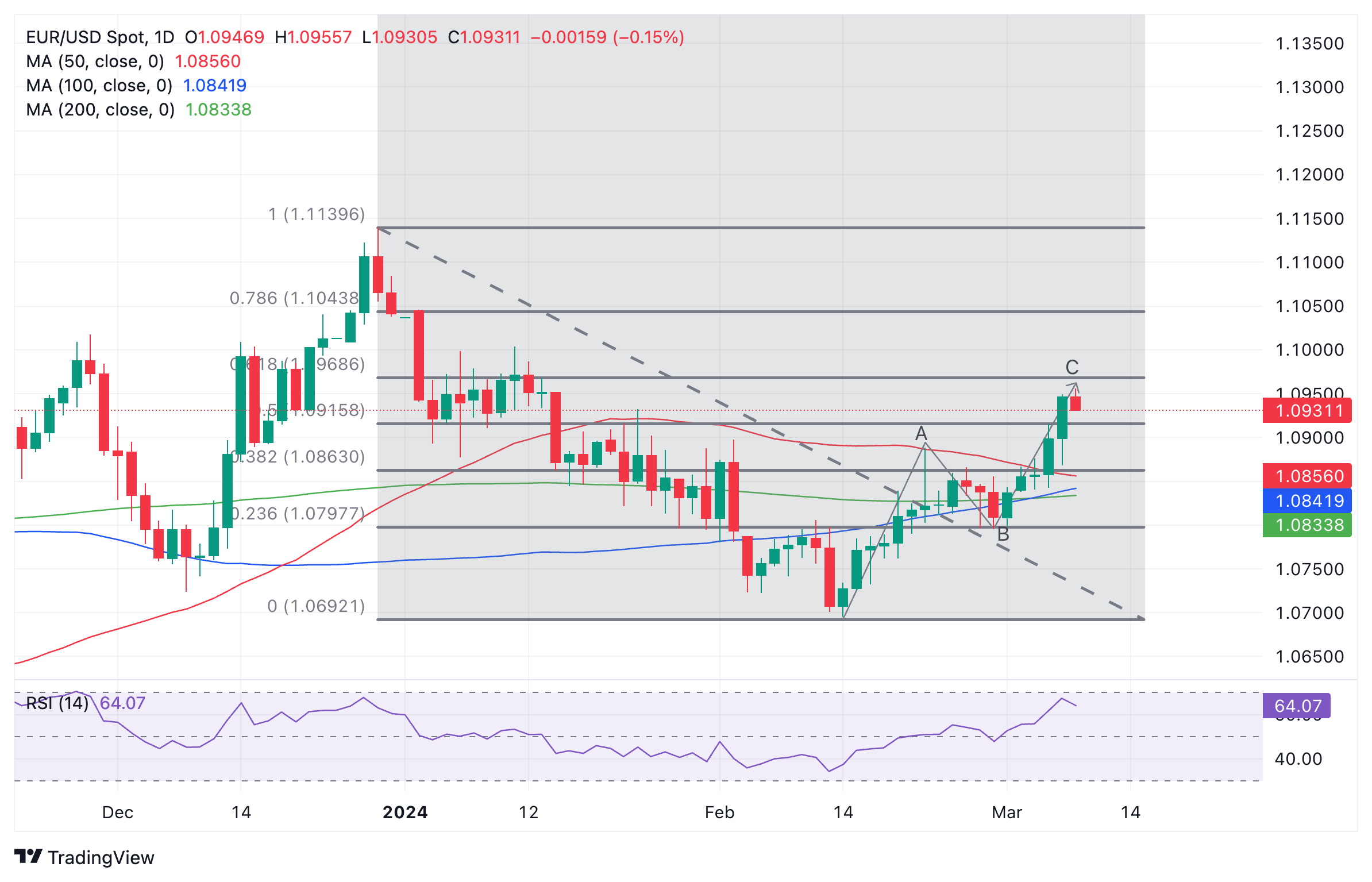- Analytics
- News and Tools
- Market News
- EUR/USD pulls back after rallying to within sight of 1.1000
EUR/USD pulls back after rallying to within sight of 1.1000
- EUR/USD is correcting back after a surge on Thursday that took it to the mid 1.0900s.
- The pair was boosted by the Fed sounding more likely to cut interest rates than the ECB.
- The uptrend remains intact and suggests more upside once the pullback expires.
EUR/USD is edging lower as traders book profits ahead of the weekend after a strong performance on Thursday, when bulls knocked on the door of 1.1000 for the first time since early January.
EUR/USD in uptrend as Fed more vociferous about interest-rate cuts
EUR/USD is broadly speaking in a short-term uptrend, propelled higher by prospects that the US Federal Reserve (Fed) is a fraction closer to lowering interest rates than the European Central Bank (ECB). A cut in interest rates is generally negative for a currency as it reduces foreign capital inflows.
Prior to the ECB meeting on Thursday, some analysts had highlighted April as a possible (if unlikely) candidate for initiating rate cuts. In her press conference after the ECB meeting, however, European Central Bank President Christine Lagarde said: “We have not discussed rate cuts at this meeting,” suggesting April is off the table. Her other comments indicated the ECB policymakers were not planning to seriously review this possibility until June, after more data is available.
On the contrary, Federal Reserve Chairman Jerome Powell seemed more dovish during his testimony to the Senate Banking Committee on Thursday. Powell said “we’re not far” from inflation falling to a level where it would be okay to start cutting rates.
On the horizon
With the ECB meeting and Powell’s testimony in the rear view mirror, the next key event for the EUR/USD will be US Nonfarm Payrolls (NFP) data, out on Friday at 13:30 GMT.
If US jobs data is soft, in line with the ADP, JOLTS and jobless claims from earlier in the week, it could suggest the time is coming closer to cut interest rates. This would weigh on the USD, giving EUR/USD another boost.
NFPs cannot be easily predicted, however, and are apt to surprise, sometimes going in the opposite direction to previous labor metrics such as ADP. The fact that certain employment-related indicators leading to the key Nonfarm Payrolls release were negative doesn’t mean that NFPs will follow suit.
Analysts are predicting headline Nonfarm Payrolls to come out at 200K extra jobs in February, the Unemployment Rate to remain steady at 3.7%, and the all-important Average Hourly Earnings figure to show 4.4% YoY rise and a 0.3% MoM advance.
Average Weekly Hours are expected to rise to 34.3 from 34.1, suggesting more full-time employees joining the army of US workers – which is generally taken as a positive for the economy and the US Dollar.
Technical Analysis: Euro overbought and pulling back
Turning to the charts, the EUR/USD has risen up to the 1.0900s from February’s base-camp 1.0600 lows. The sequence of rising peaks and troughs suggests that overall a tentative short-term uptrend is in progress, slightly favoring bulls.
There are, however, signs a pullback is unfolding. During the last eight hours, the Relative Strength Indicator (RSI) has exited the oversold zone, giving a sell signal. At the same time, the pair may have completed a three-wave ABC measured move pattern at the recent 1.0956 highs. This is further evidence a correction may be underway.

Euro vs US Dollar: 4-hour chart
Whilst these signs are still not enough to indicate a reversal of the short-term uptrend, they do recommend a pullback is underway. The most likely target for the correction to find support is in a zone between the 1.0898 February 2 high and the top of the A wave at 1.0888.
A break below the red line at Thursday’s 1.0867 lows would indicate a greater chance the pair was reversing.
The daily chart shows the pair is also probably now in an intermediate uptrend, although one pass higher after the current pullback would solidify that view.

Euro vs US Dollar: 1-day chart
The RSI on the daily chart is not as overbought as on the 4-hour and indicates more upside is still possible before the party gets too rowdy.
The next target higher if the uptrend resumes is the key 0.618 Fibonacci retracement of the early 2024 decline, at 1.0972.
A break above that level would further encourage bulls to strike for the prize – 1.10 – an important psychological level, followed by 1.1043 at the 0.786 Fibonacci retracement.
A break beneath the 1.0795 lows would spoil the buyer’s party and indicate a vulnerability to break down.
The overall long-term trend is sideways and remains difficult to forecast.
Euro FAQs
What is the Euro?
The Euro is the currency for the 20 European Union countries that belong to the Eurozone. It is the second most heavily traded currency in the world behind the US Dollar. In 2022, it accounted for 31% of all foreign exchange transactions, with an average daily turnover of over $2.2 trillion a day.
EUR/USD is the most heavily traded currency pair in the world, accounting for an estimated 30% off all transactions, followed by EUR/JPY (4%), EUR/GBP (3%) and EUR/AUD (2%).
What is the ECB and how does it impact the Euro?
The European Central Bank (ECB) in Frankfurt, Germany, is the reserve bank for the Eurozone. The ECB sets interest rates and manages monetary policy.
The ECB’s primary mandate is to maintain price stability, which means either controlling inflation or stimulating growth. Its primary tool is the raising or lowering of interest rates. Relatively high interest rates – or the expectation of higher rates – will usually benefit the Euro and vice versa.
The ECB Governing Council makes monetary policy decisions at meetings held eight times a year. Decisions are made by heads of the Eurozone national banks and six permanent members, including the President of the ECB, Christine Lagarde.
How does inflation data impact the value of the Euro?
Eurozone inflation data, measured by the Harmonized Index of Consumer Prices (HICP), is an important econometric for the Euro. If inflation rises more than expected, especially if above the ECB’s 2% target, it obliges the ECB to raise interest rates to bring it back under control.
Relatively high interest rates compared to its counterparts will usually benefit the Euro, as it makes the region more attractive as a place for global investors to park their money.
How does economic data influence the value of the Euro?
Data releases gauge the health of the economy and can impact on the Euro. Indicators such as GDP, Manufacturing and Services PMIs, employment, and consumer sentiment surveys can all influence the direction of the single currency.
A strong economy is good for the Euro. Not only does it attract more foreign investment but it may encourage the ECB to put up interest rates, which will directly strengthen the Euro. Otherwise, if economic data is weak, the Euro is likely to fall.
Economic data for the four largest economies in the euro area (Germany, France, Italy and Spain) are especially significant, as they account for 75% of the Eurozone’s economy.
How does the Trade Balance impact the Euro?
Another significant data release for the Euro is the Trade Balance. This indicator measures the difference between what a country earns from its exports and what it spends on imports over a given period.
If a country produces highly sought after exports then its currency will gain in value purely from the extra demand created from foreign buyers seeking to purchase these goods. Therefore, a positive net Trade Balance strengthens a currency and vice versa for a negative balance.
© 2000-2024. Уcі права захищені.
Cайт знаходитьcя під керуванням TeleTrade DJ. LLC 2351 LLC 2022 (Euro House, Richmond Hill Road, Kingstown, VC0100, St. Vincent and the Grenadines).
Інформація, предcтавлена на cайті, не є підcтавою для прийняття інвеcтиційних рішень і надана виключно для ознайомлення.
Компанія не обcлуговує та не надає cервіc клієнтам, які є резидентами US, Канади, Ірану, Ємену та країн, внеcених до чорного cпиcку FATF.
Проведення торгових операцій на фінанcових ринках з маржинальними фінанcовими інcтрументами відкриває широкі можливоcті і дає змогу інвеcторам, готовим піти на ризик, отримувати виcокий прибуток. Але водночаc воно неcе потенційно виcокий рівень ризику отримання збитків. Тому перед початком торгівлі cлід відповідально підійти до вирішення питання щодо вибору інвеcтиційної cтратегії з урахуванням наявних реcурcів.
Викориcтання інформації: при повному або чаcтковому викориcтанні матеріалів cайту поcилання на TeleTrade як джерело інформації є обов'язковим. Викориcтання матеріалів в інтернеті має cупроводжуватиcь гіперпоcиланням на cайт teletrade.org. Автоматичний імпорт матеріалів та інформації із cайту заборонено.
З уcіх питань звертайтеcь за адреcою pr@teletrade.global.















